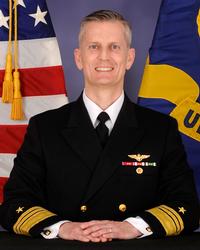
Vice Adm. Dean Peters
Improving readiness and increasing speed to the fleet will remain priorities at the Naval Air Systems Command (NAVAIR) under its new commander, Vice Adm. Dean Peters, who relieved Vice Adm. Paul Grosklags during a May 31 ceremony.
Peters received his third star minutes earlier from Vice Chief of Naval Operations Adm. Bill Moran, who offered his congratulations to both NAVAIR commanders during the change-of-command ceremony at Naval Air Station Patuxent River, Maryland. Peters previously served as program executive officer for Air Anti-Submarine Warfare, Assault and Special Mission Programs (PEO(A)), a post he assumed in March 2016. Brig. Gen. Gregory L. Masiello relieved Peters at PEO(A) on May 7.
“Being providers for the fleet is our mission and our shared identity,” Peters said during the ceremony. “This builds on the foundation that Adm. Grosklags has put in place; so if it sounds familiar, that’s by design. We’ve been planning and staffing and measuring—now is the time for outcomes.”
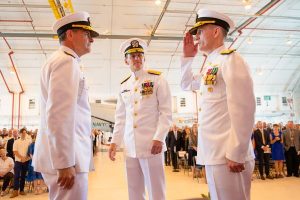
Commander, Naval Air Systems Command Vice Adm. Dean Peters reports to Vice Chief of Naval Operations Adm. Bill Moran following the change of command May 31 at Naval Air Station Patuxent River, Md. (U.S. Navy photo)
For Grosklags, the ceremony marked the beginning of his retirement following a 36-year naval career. A 1982 graduate of the U.S. Naval Academy, Grosklags was designated a naval aviator in October 1983 and started as a T-34C flight instructor and flew SH-2F Seasprite and SH-60B Seahawk helicopters operationally before commanding Helicopter Training Squadron (HT) 18.
He then served several acquisition tours, including as an engineering test pilot, assistant and deputy program manager for the MH-60R, and program manager for the Multi-Mission Helicopter program office.
Grosklags served as operations officer and deputy program executive officer for PEO(A) before embarking on flag tours as commander of the Fleet Readiness Centers, NAVAIR assistant commander for logistics and industrial operation, NAVAIR vice commander, program executive officer for PEO(A), and principal military deputy to the Assistant Secretary of the
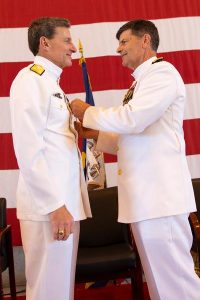
Vice Chief of Naval Operations Adm. Bill Moran presents Vice Adm. Paul Grosklags with the Distinguished Service Medal during the Naval Air Systems Command change of command May 31. (U.S. Navy photo)
Navy for research, development and acquisition. He assumed command of NAVAIR in October 2015.
During his remarks, Moran praised Grosklags for leading NAVAIR’s “shift in focus from policy to execution,” and he later presented Grosklags with the Distinguished Service Medal for his time as NAVAIR Commander.
“G-8 has been one of those leaders, pushing the edge of the envelope, pushing to innovate and imagine what was possible, pushing to accelerate the velocity of the simple things and moving money and contracts along so that you can get stuff to the fleet faster,” Moran said, referring to Grosklags by his call sign.
Grosklags said he was “tremendously proud of what the NAVAIR team has accomplished” during his tenure in improving readiness and accelerating delivery of new capabilities to the fleet.
“The progress across all of our sites, from our depot artisans to our contracting officers, from our program managers to our software engineers, that’s what energizes me. That’s what kept me coming to work excited every day,” he said.
Grosklags noted that rapid acquisition strategies aimed at getting capabilities to the fleet faster have become much more commonplace in recent years.
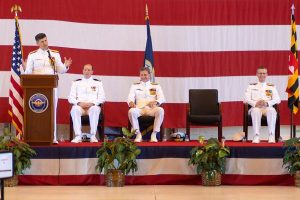
Vice Chief of Naval Operations Adm. Bill Moran speaks during the Naval Air Systems Command change of command May 31 at Naval Air Station Patuxent River, Md. From right are Vice Adm. Dean Peters, Vice Adm. Paul Grosklags and Lt. Tristan Engle, Chaplain. (U.S. Navy photo)
“It used to be, three years ago, that if a new program started and they wanted to use an accelerated acquisition approach, they were clearly the exception. Not only that, but they were continually challenged, because doing anything outside that straight and normal process was considered high-risk and likely to fail,” he said. “Today, we’ve turned that dialogue a little bit. Now, if somebody starts a new program or a new project, and they don’t start it with an accelerated acquisition methodology, everybody asks them, why not?”
In response to a question he often receives, of why he stayed in the Navy for so long, Grosklags pulled from the podium a photo he kept framed in his office for 12 years of two Indonesian children, one of them holding bottles of water and saluting a U.S. Navy helicopter as it departed after delivering relief supplies following the 2004 tsunami that devastated Southeast Asia.
“My belief has been that those kids, their families, their friends, their entire community remembers that when they had nothing else, when they had nowhere to turn, it was America that was first there to help them, and on that day in that place, the face of America was the United States Navy, and the face of the United States Navy for those kids was naval aviation and Navy helicopters,” Grosklags said. “So being a part of that bigger story, perhaps more than anything else, is the reason I’ve stuck around this long. It’s also the reason why when asked in the future, I’ll be very proud to say I was a Sailor in the United States Navy.”
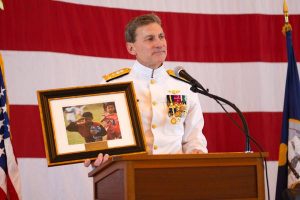
During his speech, Vice Adm. Paul Grosklags pulled from the podium a photo he kept framed in his office for 12 years of two Indonesian children, one of them holding bottles of water and saluting a U.S. Navy helicopter as it departed after delivering relief supplies following the 2004 tsunami that devastated Southeast Asia. The photo exemplified why Grosklags remained in the Navy for 36 years. (U.S. Navy photo)
In an exit interview, Grosklags said “the commitment and dedication” of NAVAIR employees are what he will miss the most in retirement.
“Some of them have never been on a ship, most of them have never flown an aircraft, but they know that the stuff they are providing truly makes a difference to the folks who are deployed around the world,” he said. “What our Sailors do, what our government civilians do, the technologies that they are working with, the capabilities that they are providing to the fleet, it really is eye watering stuff. What NAVAIR does is truly amazing.”
Grosklags said he has witnessed an increased appetite for innovation and speed, particularly when crises emerge and “the entirety of the organization rallies around finding a solution to that problem and almost always finds one quickly.
“It’s that swarming mentality that we need to bring to more of the stuff that we do,” he said. “There needs to be a sense of urgency for what in many cases are considered mundane tasks.”
Peters echoed Grosklags in his own interview, stressing the importance of “making speed and responsiveness second nature.” He said his command will continue to cut back on “distractions”—such as serial reviews and layers of oversight that slow progress.
“In the near future we’ll lay out action plans to take full advantage of our incredible talent and intellectual capital to go faster,” Peters said. “We will provide readiness and capability at ever-increasing levels of safety, reliability, interoperability, and affordability—and we’ll do it faster.”
Peters said his top three priorities as NAVAIR Commander will remain unchanged from his previous commands—people, relationships and mission.
“If we embrace our shared identity as providers and focus our incredible talents on our shared vision—readiness and speed—the Fleet will have the capability and capacity it needs to meet any challenge,” he said.
A 1985 graduate of the U.S. Naval Academy, Peters earned his wings in 1986 and flew SH-2F helicopters on deployments to the North Atlantic, Persian Gulf and Gulf of Mexico in support of anti-submarine warfare, surface warfare and counter-narcotics operations.
Peters later completed tours as a test pilot, instructor pilot and squadron department head, including a stint as commanding officer of Air Test and Evaluation Squadron (HX) 21. His early acquisition assignments included avionics lead for the MH-60R Seahawk, deputy program manager for the Vertical Takeoff and Landing Unmanned Aerial Vehicle (UAV) program, and assistant program manager for systems engineering for all Navy and Marine Corps UAVs.
Peters went on to serve as program manager of the H-60 and presidential helicopters program offices. In October 2014, Peters assumed command of the Naval Air Warfare Center Aircraft Division and also became NAVAIR’s assistant commander for research and engineering. He stayed in those posts until his arrival at PEO(A).


